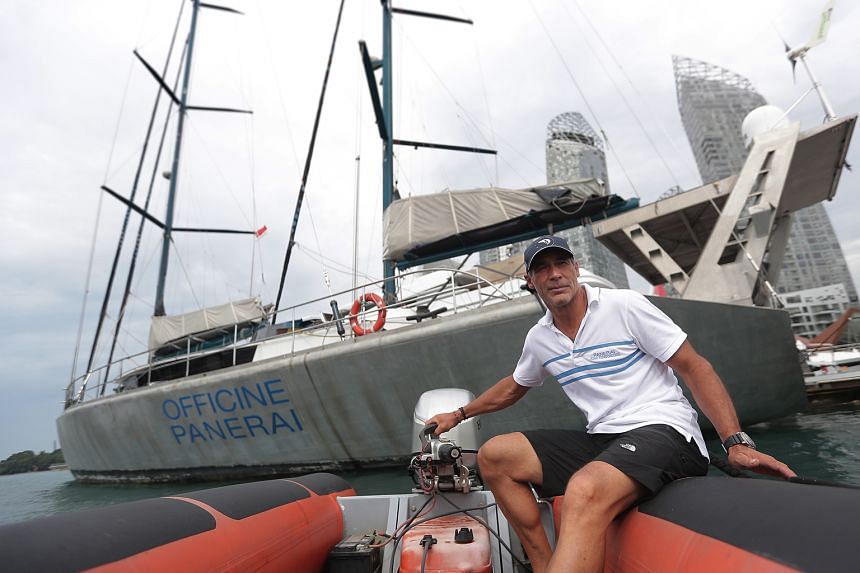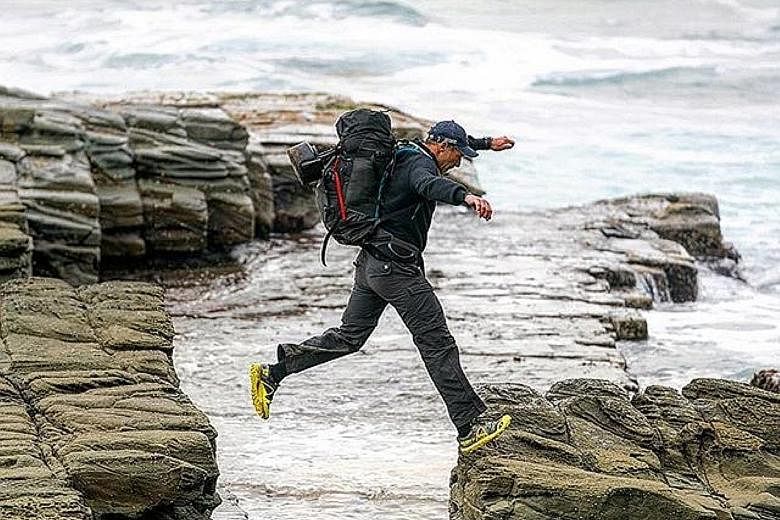Mike Horn clearly remembers the day when his late father, a university lecturer who was also a professional rugby player, scored the winning try for a game.
Later, as he proudly walked into the changing room with his old man, he said: "You know, I really want to be like you."
But his father turned around, shook his head and told his then 18-year-son that he could be much more.
Horn, now 51, says: "At that moment, I believed him. I believed that I could be better and bigger, that I shouldn't limit myself wanting to be like somebody else. I should use that as a starting point and grow bigger."
He did. Today he is one of the world's greatest adventurers and explorers, one who has scaled four of the 8,000 m summits in the Himalayas without using oxygen. There were other feats, including swimming down the Amazon River solo as well as being the first to circumnavigate the equator with no support and ski to the North Pole in the Arctic winter.
His latest undertaking is his Pole2Pole expedition, an epic 270,000 km journey which will see him linking the two poles (from South to North) on skis, kayak, an all-terrain 4×4 and his explorer sailboat, the Pangaea.
Horn is exactly what one imagines an adventurer should look like; he is well-built, fit, tanned and has a craggy, weather-beaten face.
The ruggedness is set off by an affecting affability: the extraordinary explorer, it turns out, is also a riveting raconteur.
The eldest son and second of four children, he was born in South Africa to university lecturers.
"My parents' philosophy was to give their kids not just a good education but a solid base in life with very good roots, and freedom," says Horn, whose siblings include a judge and an artist.
He and his father, who died of cancer when Horn was 18, were especially close. "He taught me that if you walk close to the cliff, you definitely see more but there's more risks involved. Because when you fall down the cliff, you've got far to fall.
"If you walk far away from the cliff, you see less but you're safer. My father said: 'You choose what you want to do and whatever you choose, we will support you'."
His physicality was not unnoticed. At 17, he was asked to try out for the elite South African Special Forces for his national service.
The training for the unit, which took in just a handful of recruits each year, was intense. "First, there was a lot of physical training to break you down. Then, there was a lot of sleep deprivation to see how you react, psychological tests, strategy planning, putting you in difficult situations where they actually hunted you," he says.
Also schooled in guerrilla and psychological warfare tactics, he spent more than two years in bloody guerrilla combat in Angola.
He once said in an interview: "I was only an 18-year-old kid when I discovered one will do anything to stay alive."

Intrigued by the link between the mind and performance, he studied Sports and Human Movement at Stellenbosch University after completing his military stint.
His first job was in his uncle's business which imported and exported fresh produce.
It didn't take long for him to make a ton of money selling cabbage, a staple in South Africa. Noticing that the country sometimes experiences a cold frost in winter when cabbage rots, he created an artificial demand. He bought supplies from farmers and made them happy by paying a higher price, and kept the cabbage in massive cooler rooms.
As he predicted, the black frost came the year he came up with the scheme. "All of a sudden, the big supermarkets that bought always from certain guys had no cabbage, had to come to me. And I said: 'You can only buy cabbage now if you keep on buying from me.' Maybe too quickly in my life, I earned a lot of money," he recalls with a chortle.
Only in his early 20s at that time, he had everything he wanted but he soon got bored. So he gave everything, including his house and car, away to family and friends and took off for the airport one day with just enough money in his pocket for an air ticket.
At the airport, he hopped on a plane to Zurich. "I didn't know what I was going to do, I only had 50 bucks in my pocket and I couldn't speak French, German or Italian. So when I got out of that plane and got my backpack, I just thought: S**t!"
From Zurich, he went to Montreux and tried looking for work.
Nobody he approached would give him work when he told them he was South African. "They would say: 'You're racist. We don't agree with South Africans, especially white South Africans.'"
To survive, he started pilfering fruits and tomatoes from gardens and taking unsold bread in supermarkets at the end of the day.
After a month, he decided to hitchhike to Israel, hoping to find work in the military or maybe a job in a kibbutz.
A guy in a pink car painted with flowers stopped for him and gave him a ride to a small village in the Swiss Alps.
It was late at night when they reached the village, so the driver, who ran a youth hostel, asked him to stay in the hostel that night.
"I told him: 'Sorry, I can't sleep in the youth hostel, I don't have money.' He said, 'Okay, you can wash the dishes and clean the rooms to pay for the room.'
Horn proved to be such a great help that the hostel owner offered him a job. He stayed, taught himself how to ski and soon became good enough to become a ski instructor.
"Then the summer came and they needed a rafting guide to take tourists down the river and although I never rafted, I said: 'I will try.' Then the tourist office in the region who had heard about me came and said: 'You know how to work with clients and people and we would like to employ you.'"
When he was not working, the adrenaline junkie sought out thrills on his own, jumping off bridges and riverboarding down rapids.
When he heard that an Italian watch company Sector was looking for riverboarders for an ad campaign, he took his flippers and boogie board and went for it.
Because he had no newspaper articles or photos of his exploits, he reckoned the best way to nab the gig was to show the two Italian interviewers what he could do.
"I told one of the guys: 'I need this. I need it more than anybody else because I think it will change my life'."
And change his life it did.
He joined the Sector No Limits sports team and chalked up a series of amazing feats chronicled in the watch company's campaigns.
In 1995, he riverboarded down a 22m tall waterfall on the upper reaches of the Pacuare River in Costa Rica.
"Then they said: 'You know of anything else to do?' I said: 'Yes, I'll swim down the Amazon.' And then they said: 'What else?' I'll go through the deepest canyon in the world.' And I had so many ideas and they just financed the expeditions," he says.
In 1997, he swam the length of Amazon River with a hydrospeed board.
"When I said I would go down the Amazon River, it kind of shocked the world. But I actually prepared myself very well; it took me over a year. I joined the Brazilian special forces in Manaus and they taught me how to survive," says Horn who, among other things, learnt what in the jungle he could eat, what lived in the water and what sort of snakes could kill him.
Two years later, he became the first man ever to circumnavigate the globe at the equator with no motorised transport. The feat, which took 17 months, won him the 2001 Laureus World Alternative Sportsperson of the Year Award.
At the awards ceremony, he met Mr Johann Rupert, chairman and founder of the Richemont Group which owns luxury watch brands such as Panerai, Vacheron Constantin and IWC.
Mr Rupert took off the Panerai he was wearing, gave it to Horn and said: "We will follow you as long as you live."
Panerai, and later Mercedes Benz, have been his sponsors since.
By then he had been married for about a decade to Cathy, a former nurse, with whom he has two daughters, now aged 24 and 25.
Cathy, who died from cancer two years ago, took care of all administrative and logistic matters relating to his expeditions. His two daughters have now stepped into that role.
His late wife, he says, was his soulmate who always pushed him to dream bigger.
"When she died, I thought that I would stop. We were planning the Pole2Pole expedition and when she died, my dream died with her," he says.
But his daughters Annika and Jessica, who drove with him across Europe and Asia to the base camp of K2 on the Pakistan-China border after Cathy's death, would have none of it.
"They said: 'You know, Papa, you planned this expedition with Mama and you're not leaving. It's an insult. Do it for her and we will support you now'."
And that is why Horn is now navigating the globe North-South.
"It's everything I've done as an explorer in one expedition," says Horn who earlier this year became the first man to cross Antarctica solo.
On several occasions during his expeditions, he has diced with death. But he knows when to scale back.
Dangerous conditions made him call off an attempt to get to the top of K2, the world's second-highest peak, in 2012 even though he was less than 1,500m from the top. Other teams which went ahead died in an avalanche.
"I do what I do, not to die but to live," Horn says.

Besides his expeditions, he also gives motivational talks and has done two television shows on survival training and adventure on French TV.
In 2007, he launched the Young Explorers Programme where he invites teens and young adults on adventure journeys "to explore, learn and act" aboard Pangaea, the 35m sailing boat that he calls his SUV of the oceans.
Horn says he was born an explorer.
"I don't think you can become an explorer one day by just deciding. I think you're born to be who you are. A lot of people often don't really find who they are because they're so influenced by external factors that channel them into a direction that they might not want to take themselves."
The Pole2Pole expedition, he says, will probably take another year to complete.
What next then?
"I think that there's a lot to do under the ocean because that is a frontier that is still pretty much unknown for us. And then there's always space."



